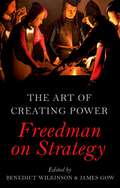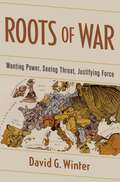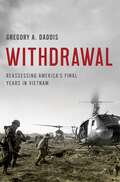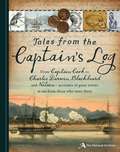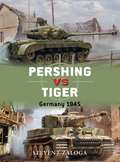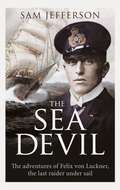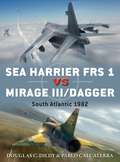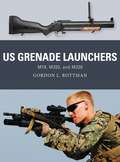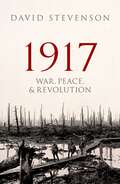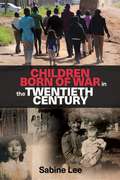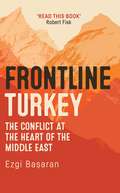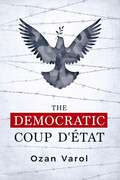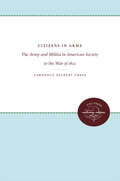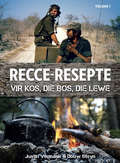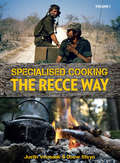- Table View
- List View
The Art of Creating Power: Freedman on Strategy
by Benedict Wilkinson James GowThe Art of Creating Power explores the intellectual thought and wider impact -- on military affairs, politics and the universities -- of Professor Sir Lawrence Freedman, one of the world's leading authorities on strategy, conflict and international politics. In this volume, senior scholars of international relations and military history trace the long trajectory of Freedman's career, examining his scholarly contribution to a whole host of areas from nuclear strategy to US foreign policy via terrorism, the Falklands War, and Iraq. Individually, these essays provide fascinating and innovative insights into strategy, contemporary defence and foreign policy, and conflict. Taken together, however, they are greater than the sum of their parts as they both reflect and explore the theoretical approach adopted and taught by Freedman - one that has made him one of the great intellectual figures in the canon of international politics, strategy and war. Throughout his professional life, Freedman explored many of the uncertainties that plague our highly unstable world. But as conflicts continue to erupt across the globe, it seems we may be entering an even more precarious and uncertain era. There could hardly be a better time than today to gain a deeper understanding of Freedman's strategic insights.
Roots of War: Wanting Power, Seeing Threat, Justifying Force
by David G. WinterEver since Thucydides pondered reasons for the outbreak of the Peloponnesian War, writers, philosophers, and social scientists have tried to identify factors that promote conflict escalation: for example, history (tomorrow's wars are often rooted in yesterday's conflicts), changing balance of power among nations, or domestic political forces. In the end, however, these "causes" are constructed by human beings and involve the memories, emotions, and motives of both the leaders and the led. In July 1914, the long-standing peace of Europe was shattered when the Sarajevo assassinations quickly escalated to World War I. In contrast, at the height of the Cold War, the Cuban Missile Crisis could have easily plunged the world into a thermonuclear world war, but was ultimately peacefully resolved. Why the different outcomes? In Roots of War: Wanting Power, Seeing Threat, Justifying Force, David G. Winter identifies three psychological factors that contributed to the differences in these historical outcomes: the desire for power, exaggerated perception of the opponent's threat, and justification for using military force. Several lines of research establish how these factors lead to escalation and war: comparative archival studies of "war" and "peace" crises, laboratory experiments on threat perception, and surveys of factors leading people to believe that a particular war is "just." The research findings in Roots of War also demonstrate the importance of power in preserving peace through diplomatic interventions, past and present.
Withdrawal: Reassessing America's Final Years in Vietnam
by Gregory A. DaddisA "better war." Over the last two decades, this term has become synonymous with US strategy during the Vietnam War's final years. The narrative is enticingly simple, appealing to many audiences. After the disastrous results of the 1968 Tet offensive, in which Hanoi's forces demonstrated the failures of American strategy, popular history tells of a new American military commander who emerged in South Vietnam and with inspired leadership and a new approach turned around a long stalemated conflict. In fact, so successful was General Creighton Abrams in commanding US forces that, according to the "better war" myth, the United States had actually achieved victory by mid-1970. A new general with a new strategy had delivered, only to see his victory abandoned by weak-kneed politicians in Washington, DC who turned their backs on the US armed forces and their South Vietnamese allies. In a bold new interpretation of America's final years in Vietnam, acclaimed historian Gregory A. Daddis disproves these longstanding myths. Withdrawal is a groundbreaking reassessment that tells a far different story of the Vietnam War. Daddis convincingly argues that the entire US effort in South Vietnam was incapable of reversing the downward trends of a complicated Vietnamese conflict that by 1968 had turned into a political-military stalemate. Despite a new articulation of strategy, Abrams's approach could not materially alter a war no longer vital to US national security or global dominance. Once the Nixon White House made the political decision to withdraw from Southeast Asia, Abrams's military strategy was unable to change either the course or outcome of a decades' long Vietnamese civil war. In a riveting sequel to his celebrated Westmoreland's War, Daddis demonstrates he is one of the nation's leading scholars on the Vietnam War. Withdrawal will be a standard work for years to come.
Tales from the Captain's Log
by The National ArchivesFor centuries, ships' commanders kept journals that recorded their missions. These included voyages of discovery to unknown lands, engagements in war and sea and general trade. Many of their logs, diaries and letters were lodged at The National Archives and give a vivid picture of the situations that they encountered. Entries range from Captain James Cook's notes of his discovery of the South Pacific and Australia, to logs of the great naval battles, such as Trafalgar and the Battle of the Nile. From the ships that attempted to stop piracy in the Caribbean, to the surgeons who recorded the health of the men they tended and naturalists who noted the exotic plants and animals they encountered, comes a fascinating picture of life at sea, richly illustrated with maps, drawings and facsimile documents found alongside the logs in the archives.
Morale: A Modern British History
by Daniel UssishkinArguably no nation is as closely associated with the term morale as Great Britain. Yet this concept that seems so innate to the British people was carefully cultivated within many spheres of modern national life. In this first critical history of morale, Daniel Ussishkin asks how is it that modern Britons have come to regard morale as a category of conduct, vital for the success of collective effort in war and peace, and a mark of good, modern, and human managerial practice, appropriate for a democratic age. He narrates the intellectual, cultural, and institutional history of morale in modern imperial Britain: its emergence as a new concept during the long nineteenth century, its changing meanings and significations, and the social and political goals those who discussed, observed, or managed morale sought to achieve. Formalized as a new military disciplinary problem during the long nineteenth century, morale came to permeate nearly every civilian sphere of life during the era of the two world wars as a new way of managing human conduct. This book traces how it gradually emerged from a problem that was regarded as residual at best to one that was seen as the epitome of proper managerial practice, its institutional manifestations and promotion by myriad organizations and the social-democratic state, and its emergence as a potent political concept from Britain's social-democratic moment until the ascendancy of the New Right. Daniel Ussishkin's Morale tells the history of concept central to the management of war, business, and civic society not just in Britain but in modern culture writ large.
D-Day Beach Assault Troops (Elite)
by Peter Dennis Gordon L. RottmanIn the early hours of June 6, 1944, the first of over 150,000 Allied soldiers stormed five beaches in Normandy against fierce German resistance. They were specially trained and task-organized in a range of different landing teams depending on their means of transport, their tasks, and the resistance they anticipated. The first assault infantry were accompanied by tankers, combat engineers, and other specialist personnel, to breach German obstacles, knock out defensive positions, and to defend and prepare the beaches for the follow-on waves. On some beaches the plans worked, on others they were disrupted by bad weather, faulty timing, or enemy fire, with consequences that varied from survivable confusion to absolute carnage. This is an in-depth study of the uniforms, equipment, weapons, passage, landings, and tactics of US, British and Canadian assault units during the period from before H-Hour on June 6 to dawn on June 7.
The Improbable Victory: In Association with The American Revolution Museum at Yorktown
by Chris McNabThe American Revolution reshaped the political map of the world, and led to the birth of the United States of America. Yet these outcomes could have scarcely been predicted when the first shots were fired at Lexington and Concord. American rebel forces were at first largely a poorly trained, inexperienced and disorganized militia, pitted against one of the most formidable imperial armies in the world. Yet following a succession of defeats against the British, the rebels slowly rebounded in strength under the legendary leadership of George Washington. The fortunes of war ebbed and flowed, from the humid southern states of America to the frozen landscapes of wintry Canada, but eventually led to the catastrophic British defeat at Yorktown in 1781 and the establishment of an independent United States of America.The Improbable Victory is a revealing and comprehensive guide to this seminal conflict, from the opening skirmishes, through the major pitched battles, up to the Treaty of Paris in 1783. Impressively illustrated with photographs and artwork, it provides an invaluable insight into this conflict from the major command decisions down to the eye level of the front-line soldier.
Maginot Line Gun Turrets: And French gun turret development 1880–1940 (New Vanguard)
by Donato Spedaliere Clayton DonnellThe Maginot Line was one of the most advanced networks of fortifications in history. Built in the aftermath of World War I, and stretching along the French eastern border from Belgium to Switzerland, it was designed to prevent German troops from ever setting foot on French soil again.Its primary defensive weapons were the gun turrets. Beginning development in the 1870s and improving on German designs, they were constructed out of steel wedges and could revolve and disappear from sight after firing, making them impervious to enemy bombardment. They were deadly accurate and created havoc on the German units that attacked the line during their invasion of France in 1940.This fully illustrated study will examine the technical details of the French artillery turrets. It will show the evolution of the design of the guns and turrets used in the French forts before and during World War I, then those built exclusively for the Maginot Line to give a comprehensive overview of the weapons designed to protect France from invasion.
MiG-21 Aces of the Vietnam War (Aircraft of the Aces)
by Jim Laurier Gareth Hector István ToperczerHaving learned their trade on the subsonic MiG-17, pilots of the Vietnamese People's Air Force (VPAF) received their first examples of the legendary MiG-21 supersonic fighter in 1966. Soon thrown into combat over North Vietnam, the guided-missile equipped MiG-21 proved a deadly opponent for the US Air Force, US Navy and US Marine Corps crews striking at targets deep in communist territory. Although the communist pilots initially struggled to come to terms with the fighter's air-search radar and weapons systems, the ceaseless cycle of combat operations quickly honed their skills. Indeed, by the time the last US aircraft (a B-52) was claimed by the VPAF on 28 December 1972, no fewer than 13 pilots had become aces flying the MiG-21. Fully illustrated with wartime photographs and detailed colour artwork plates, and including enthralling combat reports, this book examines the many variants of the MiG-21 that fought in the conflict, the schemes they wore and the pilots that flew them.
Operation Torch 1942: The invasion of French North Africa (Campaign)
by Darren Tan Nikolai Bogdanovic Brian Lane HerderFollowing the raid on Pearl Harbor and the entry of the United States into World War II, President Franklin D. Roosevelt identified the European theatre as his country's priority. Their first joint operation with the British was an amphibious invasion of French North Africa, designed to relieve pressure on their new Soviet allies, eliminate the threat of the French navy joining the Germans, and to shore up the vulnerability of British imperial possessions and trade routes through the Mediterranean.Operation Torch was the largest and most complex amphibious invasion of its time. In November 1942, three landings took place simultaneously across the French North African coast in an ambitious attempt to trap and annihilate the Axis' North African armies between the invading forces under General Eisenhower and British Field-Marshall Montgomery's Eighth Army in Egypt. Using full colour artwork, maps and contemporary photographs, this is the thrilling story of this complex operation.
Panther
by Thomas AndersonThe German Panther is one of the most famous, and greatest, tanks of World War II. Often considered the most elegant tank design of the war, it embodied a balance of firepower, armour protection, and mobility unmatched by any other tank of the period. This new study by German armour expert Thomas Anderson draws upon original German archival material to tell the story of the birth of the Panther in response to the Soviet tanks encountered in 1941. He then analyzes its success on the battlefield and the many modifications and variants that also came into play. Illustrated throughout with rare photographs and drawings, many of which have never been published in English before, this is a unique history of one of the most famous tanks of World War II.
Pershing vs Tiger: Germany 1945 (Duel)
by Steven J. Zaloga Jim LaurierDuring the final battles on World War II's Western Front, the legendary German Tiger I heavy tank clashed with the brand-new M26 Pershing fielded by the United States. The Tiger I had earned a formidable reputation by the end of 1944, although its non-sloped armour and poor mobility meant it was being superseded by the Tiger II or 'King Tiger'. While the Tiger I had been in the front lines since 1942, the US Pershing first entered combat in late February 1945, and more than 20 Pershings would see action before war's end.This book examines the dramatic Tiger/Pershing duel at Elsdorf in Germany, and also assesses the clashes between German armour and the sole 'Super Pershing' deployed to Europe. Featuring full-colour artwork, carefully chosen photographs and specially commissioned maps, this is the story of the first US heavy tanks in combat with the fearsome Tiger I during the last months of World War II in Europe.
The Philippine Sea 1944: The last great carrier battle (Campaign #313)
by Jim Laurier Mark Stille Bounford.com Bounford.comAfter suffering devastating losses in the huge naval battles at Midway and the Soloman Islands, the Imperial Japanese navy attempted to counter-attack against the US forces threatening the Home Islands. Involving the US Fifth Fleet and the Japanese Mobile Fleet, the battle of the Philippine Sea took place during the United States' amphibious invasion of the Mariana Islands during the Pacific War.The two fleets clashed on 19-20 June 1944 and the Japanese carrier fighters were shot down in devastating numbers by US aircraft in what became known as the “Great Marianas Turkey Shoot”, before US counterattacks and submarine strikes forced the withdrawal of the Japanese fleet. Fully illustrated with stunning specially commissioned artwork, Mark Stille tells the enthralling story of the last, and largest, carrier battle of the Pacific War, the one that saw the end of the Imperial Japanese Navy as a formed fighting force.
The Sea Devil: The Adventures of Count Felix von Luckner, the Last Raider under Sail
by Sam JeffersonIn 1916, a three-masted windjammer bearing Norwegian colours sailed out of a quiet anchorage in Germany, loaded with cargo and apparently bound for Australia. Her true mission was quite different.The ship was, in fact, the SMS Seeadler, commanded by swashbuckling German aristocrat Felix von Luckner. Over an epic voyage, he used cunning and deception to destroy fourteen merchant ships, all the while evading the utterly foxed and infuriated British Admiralty in a daring game of cat and mouse.This rip-roaring World War I story depicts a life of espionage, counterespionage and piracy of the most gentlemanly kind.
Sea Harrier FRS 1 vs Mirage III/Dagger: South Atlantic 1982 (Duel)
by Jim Laurier Doug Dildy Gareth Hector Pablo CalcaterraFollowing Argentina's military operation to take possession of the Falkland Islands/Islas Malvinas, British Prime Minister Margaret Thatcher's government launched a major naval operation to return them to British rule. Defending the Royal Navy task force were two small squadrons totalling 20 Sea Harriers (SHARs). Initial clashes between SHARs and Argentine Mirages and Daggers on 1 May 1982 failed to eliminate the Sea Harrier defenders. FAA fighter-bomber pilots relied on daring and courageous ultra-low level attacks, frequently escaping the Sea Harrier's limited capabilities, against Royal Navy warships and auxiliaries, causing considerable damage during Operation Corporate, the large-scale amphibious operation to repossess the islands.Publishing 35 years after the end of the conflict, this fully illustrated volume offers a balanced and objective examination of the SHAR and the Argentine Mirage and Dagger aircraft, highlighting the attributes of both and the skills and courage of the pilots flying them.
The Splintered Empires: The Eastern Front 1917–21
by Prit ButtarAt the beginning of 1917, the three empires fighting on the Eastern Front were reaching their breaking points, but none was closer than Russia. After the February Revolution, Russia's ability to wage war faltered and her last desperate gamble, the Kerensky Offensive, saw the final collapse of her army. This helped trigger the Bolshevik Revolution and a crippling peace, but the Central Powers had no opportunity to exploit their gains and, a year later, both the German and Austro-Hungarian empires surrendered and disintegrated.Concluding his acclaimed series on the Eastern Front in World War I, Prit Buttar comprehensively details not only these climactic events, but also the 'successor wars' that raged long after the armistice of 1918. New states rose from the ashes of empire, and war raged as German forces sought to keep them under the aegis of the Fatherland. These unresolved tensions between the former Great Powers and the new states would ultimately lead to the rise of Hitler and a new, terrible world war only two decades later.
US Grenade Launchers: M79, M203, and M320 (Weapon)
by Gordon L. Rottman Johnny Shumate Alan GillilandIn an effort to provide the US infantryman with more firepower to cover the range gap between the hand grenade and the light mortar, the 40mm M79 grenade launcher – a shoulder-fired, single-shot weapon – entered service with US forces in 1961.Reliable, easy to use, and lethally effective, the M79 soon became an iconic symbol of the Vietnam War and had a profound influence on small-unit tactics. As the Vietnam conflict continued, it was joined on the front line by experimental models such as the magazine-fed T148E1, as well as two launchers intended to be fitted under the barrel of the new M16 assault rifle: Colt's XM148 and AAI Corporation's M203. The M203 remains in US Army service today, while the US Marine Corps now also fields the M32 multiple grenade launcher – like the M79, a standalone weapon. Featuring full-colour artwork, this is the story of the rugged and formidable grenade launchers that equipped the United States and its allies in Vietnam and beyond from the 1960s to the present day.
1917: War, Peace, and Revolution
by David Stevenson1917 was a year of calamitous events, and one of pivotal importance in the development of the First World War. In 1917: War, Peace, and Revolution, leading historian of World War One, David Stevenson, examines this crucial year in context and illuminates the century that followed. He shows how in this one year the war was transformed, but also what drove the conflict onwards and how it continued to escalate. Two developments in particular — the Russian Revolution and American intervention — had worldwide repercussions. Offering a close examination of the key decisions, David Stevenson considers Germany's campaign of 'unrestricted' submarine warfare, America's declaration of war in response, and Britain's frustration of German strategy by adopting the convoy system, as well as why (paradoxically) the military and political stalemate in Europe persisted. Focusing on the abdication of Tsar Nicholas II, on the disastrous spring offensive that plunged the French army into mutiny, on the summer attacks that undermined the moderate Provisional Government in Russia and exposed Italy to national humiliation at Caporetto, and on the British decision for the ill-fated Third Battle of Ypres (Passchendaele), 1917 offers a truly international understanding of events. The failed attempts to end the war by negotiation further clarify the underlying forces that kept it going. David Stevenson also analyses the global consequences of the year's developments, showing how countries such as Brazil and China joined the belligerents, Britain offered 'responsible government' to India, and the Allies promised a Jewish national home in Palestine. Blending political and military history, and moving from capital to capital and between the cabinet chamber and the battle front, the book highlights the often tumultuous debates through which leaders entered and escalated the war, and the paradox that continued fighting could be justified as the shortest road towards regaining peace.
Children born of war in the twentieth century
by Sabine LeeThis book explores the life courses of children born of war in different twentieth-century conflicts, including the Second World War, the Vietnam War, the Bosnian War, the Rwandan Genocide and the LRA conflict. It investigates both governmental and military policies vis-à-vis children born of war and their mothers, as well as family and local community attitudes, building a complex picture of the multi-layered challenges faced by many children born of war within their post-conflict receptor communities. Based on extensive archival research, the book also uses oral history and participatory research methods which allow the author to add the voices of the children born of war to historical analysis.
Frontline Turkey: The Conflict at the Heart of the Middle East
by Ezgi BasaranTurkey is on the front line of the war which is consuming Syria and the Middle East. Its role is complicated by the long-running conflict with the Kurds on their Syrian border – a war that has killed as many as 80,000 people over the last three decades. In 2011 Erdogan promised to make a deal with the Kurdistan military wing, but the talks marked a descent into assassinations, suicide bombings and the killing of civilians on both sides. The Kurdish peace process finally collapsed in 2014 with the spill-over of the Syrian Civil War. With ISIS moving through northern Iraq, Turkey has declared war on western allies such as the Kurdish YPG – the military who rescued the Yezidis and fought with US backing in Kobane. Frontline Turkey shows how the Kurds' relationship with Turkey is at the very heart of the Middle Eastern crisis, and documents, through front-line reporting, how Erdogan's failure to bring peace is the key to understanding current events in Middle East.
The Hazaras and the Afghan State: Rebellion, Exclusion and the Struggle for Recognition
by Niamatullah IbrahimiThe Hazaras of Afghanistan have borne the brunt of many of the destructive forces unleashed by the establishment of the Afghan monarchy in 1747. The history of their relationship with the Afghan state has been punctuated by frequent episodes of ethnic cleansing, mass dispossession, forced displacement, enslavement and social and economic exclusion. Mostly Shia in a country dominated by Sunni Muslims, and identifiable because of their Asian features, the Hazaras became Afghanistan's internal 'Other'. They look different and practice a different school of Islam in a country that is prone to internal conflict and the machinations of external powers. The history of the Hazaras therefore offers a unique perspective into the deep contradictions of Afghanistan as a modern state, and how its ethnic and religious dynamics continue to undermine the post-2001 political process. This volume provides a fresh account of both the strategies and tactics of the Afghan state and how the Hazaras have responded to them, focusing on three key phenomena: Hazara rebellion and resistance to the intrusion of the Afghan state in the nineteenth century; the incorporation of the Hazara homeland into Afghanistan in the 1890s and their subsequent marginalization and exclusion; and the Hazaras' ethnic mobilization and struggle for recognition in recent decades.
The Democratic Coup d'État
by Ozan O. VarolThe term coup d'état--French for stroke of the state--brings to mind coups staged by power-hungry generals who overthrow the existing regime, not to democratize, but to concentrate power in their own hands as dictators. We assume all coups look the same, smell the same, and present the same threats to democracy. It's a powerful, concise, and self-reinforcing idea. It's also wrong. In The Democratic Coup d'État, Ozan Varol advances a simple, yet controversial, argument: Sometimes, a democracy is established through a military coup. Covering events from the Athenian Navy's stance in 411 B.C. against a tyrannical home government, to coups in the American colonies that ousted corrupt British governors, to twentieth-century coups that toppled dictators and established democracy in countries as diverse as Guinea-Bissau, Portugal, and Colombia, the book takes the reader on a gripping journey. Connecting the dots between these neglected events, Varol weaves a balanced narrative that challenges everything we thought we knew about military coups. In so doing, he tackles several baffling questions: How can an event as undemocratic as a military coup lead to democracy? Why would imposing generals-armed with tanks and guns and all-voluntarily surrender power to civilian politicians? What distinguishes militaries that help build democracies from those that destroy them? Varol's arguments made headlines across the globe in major media outlets and were cited critically in a public speech by Turkish President Recep Tayyip Erdogan. Written for a general audience, this book will entertain, challenge, and provoke, but more importantly, serve as a reminder of the imperative to question the standard narratives about our world and engage with all ideas, no matter how controversial.
Citizens in Arms: The Army and Militia in American Society to the War of 1812
by Lawrence Delbert CressThis first study to discuss the important ideological role of the military in the early political life of the nation examines the relationship between revolutionary doctrine and the practical considerations of military planning before and after the American Revolution. Americans wanted and effective army, but they realized that by its very nature the military could destroy freedom as well as preserve it. The security of the new nation was not in dispute but the nature of republicanism itself.Originally published 1982. A UNC Press Enduring Edition -- UNC Press Enduring Editions use the latest in digital technology to make available again books from our distinguished backlist that were previously out of print. These editions are published unaltered from the original, and are presented in affordable paperback formats, bringing readers both historical and cultural value.
Recce-resepte: Vir kos, die bos, die lewe
by Justin Vermaak Douw SteynAasvoëlsop, enigiemand? Of wat van vlieënde vis vir voorgereg met gebraaide luislang vir hoofgereg?Recce-resepte vir kos, die bos, die lewe is vol tong-in-die-kies resepte en stories oor die Recces se ervarings gedurende die Grensoorlogjare en tot 1997. Die boek plaas jou in die skoene van hierdie legendariese en geheimsinninge Spesiale Magte-operaters. Ontdek wat dit verg om vir weke aaneen uit 'n rugsak te leef, hoe om te oorleef op dit wat die natuur versaf en selfs hoe om 'n leeu kaalhand van 'n karkas te verjaaf. Die stories oor hul waaghalsige operasies gedurende die eerste 25 jaar van die Spesiale Magte vat jou van Durban na Langebaan en deur Phalaborwa na die res van Afrika en selfs Rusland.Hulle verklap boonop hul unieke filosofie – bly in die oomblik, pas aan en doen jou ding! Of staan opsy, want die Recces kom verby …WAARSKUWING: Hoewel die meeste resepte eetbaar is, moet sommige nooit, ooit herhaal word nie.
The Recce Way: Specialised Cooking
by Justin Vermaak Douw SteynVulture soup, anyone? Or how about some fried python with a side order of diesel-dipped dog biscuits? Specialised cooking – The Recce Way gives a unique perspective on the lives of South Africa's legendary Special Forces soldiers. The book combines tongue-in-cheek recipes with anecdotes of the men's experiences during the Border War, and up to 1997, putting the gruel into gruelling. It shows what it takes to live out of a rucksack for weeks on end and how to make do with what nature has to offer.Highlighting the scope of the activities of the first 25 years of the Special Forces, the book takes us from Durban to Langebaan, through Phalaborwa into the rest of Africa, and from the firing line to a braai on top of a submarine out at sea. Most importantly, it overflows with the Recce philosophy for excelling in adverse conditions – stay in the moment, adapt, adjust and just get on with it!WARNING: While most of the meals in this book are edible, some should never, ever, be repeated.
